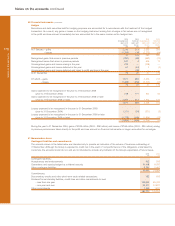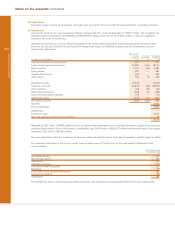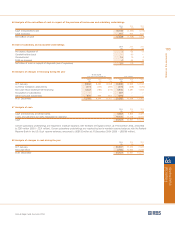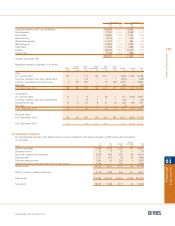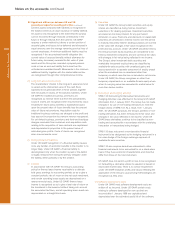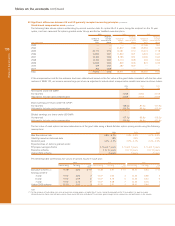RBS 2004 Annual Report Download - page 189
Download and view the complete annual report
Please find page 189 of the 2004 RBS annual report below. You can navigate through the pages in the report by either clicking on the pages listed below, or by using the keyword search tool below to find specific information within the annual report.
section
03
187
Annual Report and Accounts 2004
Notes on the accounts
Financial
statements
(a) At 31 December 2004, the amounts outstanding in relation
to transactions, arrangements and agreements entered into
by authorised institutions in the Group were £234,265 in
respect of loans to eight persons who were directors of
the company (or persons connected with them) at any time
during the financial period and £30,926 to one person who
was an officer of the company at any time during the
financial period.
(b) There were no contracts of significance to the business of
the company and its subsidiaries which subsisted at 31
December 2004, or during the year then ended, in which
any director of the company had a material interest.
Subsidiary undertakings
In accordance with Financial Reporting Standard 8 ‘Related
Party Disclosures’ (“FRS 8”), transactions or balances between
Group entities that have been eliminated on consolidation are
not reported.
Investments
Group members provide development and other types of
capital support to businesses in their roles as providers of
finance. These investments are made in the normal course of
business and on arm’s-length terms depending on their nature.
In some instances, the investment may extend to ownership or
control over 20% or more of the voting rights of the investee
company. However, these investments are not considered to
give rise to transactions of a materiality requiring disclosure
under FRS 8.
Pension Fund
The Group recharges The Royal Bank of Scotland Group
Pension Fund with the cost of administration services incurred
by it. The amounts involved are not material to the Group.
The consolidated financial statements of the Group are
prepared in accordance with UK generally accepted
accounting principles (“GAAP”) that differ in certain material
respects from US GAAP. The significant differences are
summarised as follows:
(a) Acquisition accounting
Under UK GAAP, all integration costs relating to
acquisitions are expensed as post-acquisition expenses.
Under US GAAP, certain restructuring and exit costs
incurred in the acquired business are treated as liabilities
assumed on acquisition and taken into account in the
calculation of goodwill.
Under UK GAAP, provisional fair value adjustments made in
the accounting year in which the acquisition occurs may
be amended in the subsequent accounting year. Under US
GAAP, the allocation of the cost of acquisition to the fair
values of assets and liabilities is generally completed
within 12 months of the date of acquisition.
(b) Intangible assets
Under the Group’s UK GAAP accounting policy, goodwill
arising on acquisitions after 1 October 1998 is recognised
as an asset and amortised on a straight-line basis over its
estimated useful economic life. Impairment tests on goodwill
are carried out at the end of the first full accounting period
after its acquisition, and whenever there are indications of
impairment. Goodwill arising on acquisitions before 1
October 1998 was deducted from reserves immediately.
Under US GAAP, goodwill is recognised as an asset, and is
not amortised. Under the transition rules of SFAS 142
‘Goodwill and Other Intangible Assets’, no amortisation is
charged on acquisitions made after 30 June 2001;
amortisation is charged up to 31 December 2001 for other
goodwill. All goodwill and intangible assets with indefinite
lives are tested for impairment at least annually. Certain
amounts included in goodwill under UK GAAP are
classified as intangible assets under US GAAP and
amortised over their useful economic lives.
(c) Property revaluation and depreciation
The Group’s freehold and leasehold properties are carried
at original cost or subsequent valuation. The surplus or
deficit on revaluation is included in the Group’s reserves.
Under US GAAP, revaluations of property are not permitted
to be reflected in the financial statements.
Depreciation charged and gains or losses on disposal
under UK GAAP are based on the revalued amount of
freehold and long leasehold properties; no depreciation is
charged on investment properties which are revalued
annually. Under US GAAP, the depreciation charge and
gains or losses on disposal are based on the historical
cost for all properties.
(d) Leasehold property provisions
Under UK GAAP, provisions are raised on leasehold
properties when there is a commitment to vacate the
property. US GAAP requires provisions to be recognised
at the time the property is vacated.
(e) Dividends
Under UK GAAP, dividends are recorded in the period to
which they relate, whereas under US GAAP dividends are
recorded in the period in which they are declared.
(f) Loan origination
Under UK GAAP, certain loan fees are recognised when
received. Under US GAAP, applicable non-refundable loan
fees and certain direct costs are deferred and recognised
over the period of the related loan or facility.
(g) Pension costs
Under UK GAAP, pension assets are measured at their fair
value and scheme liabilities are measured on an actuarial
basis using the projected unit method and discounted at
the current rate of return on a high quality corporate bond
of equivalent term and currency. Any surplus or deficit of
52 Related party transactions
53 Significant differences between UK and US
generally accepted accounting principles
51 Transactions with directors, officers and others



